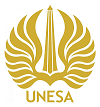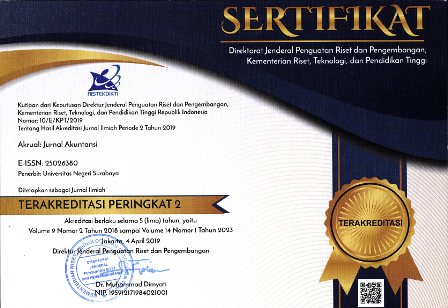Pemanfaatan Website Direktorat Jenderal Pajak Oleh Akuntan Pemerintah Di Kalimantan Timur
DOI:
https://doi.org/10.26740/jaj.v5n2.p168-183Keywords:
perceived usefulness, perceived ease of use, psychologicalattachment, attitude, behavior intentionAbstract
Abstract
This research aimed to examine the effect ofperceived usefulness variable, perceived ease of use variable and psychological attachment variable to attitude inusing information technology. Attitude will influence the behavior specifically inutilizing information technology concern shown bythe behavior. Data was obtained through the questionnaire survey with a purposely sampling technique with the criteria, accountants who utilize tax website that www.pajak.go.id in performing their work. Accountants who are being sample do f this study is accountant who are in government organizations. Analysis of the data in this research uses Structural Equation Modeling (SEM) with an alternative method of PLS (Partial Least Square) which is assisted with the application program Smart PLS. Based onthe results of the research be concluded that 1) there is no significant relationship between perceived usefulness and attitude variables in the utilizationof taxwebsite (www.pajak.go.id.); 2) there is asignificant relationship between the variables of perceived ease of use and attitude in the use of website taxation (www.pajak.go.id); 3) there is no significant relationship between the variables of psychological attachment and attitude in the utilization of tax website(www.pajak.go.id); 4) there is asignificant relationship between attitude and behavior variables intention to use the website taxation (www.pajak.go.id).
Key Words: perceived usefulness, perceived ease of use, psychologicalattachment, attitude, behavior intention.
References
Gardner, Christina; Amoroso, Donald L. (2004). Development of an Instrument to Measure the Acceptance of Internet Technology by Consumers. Proceedings of the 37th Hawaii International Conference on System Sciences. https://doi.org/10.1109/hicss.2004.1265623
Hartono, Jogiyanto. (2005). Sistem Teknologi Informasi. Andi Offset, Yogyakarta.
Heslin, J. Alexander. (1996). How Critical is Ease of Use in Adopting an Information Technology. An Empirical Study, Proceedings of the 3rd Symposium on Human Interaction with Complex Systems (HICS '96) © IEEE. https://doi.org/10.1109/huics.1996.549495
Hubona, Geoffrey S.; Geitz, Sarah. (1997). External Variables, Beliefs, Attitudes And Information Technology Usage Behavior. Proceedings of The Thirtieth Annual Hawwaii International Conference on System Sciences ISBN 0-8186-7862-3/97 IEEE. https://doi.org/10.1109/hicss.1997.661560
Kang, Sungmin. (1998). Information Technology Acceptance: Evolving with the Changes in the Network Environment. Center for Information Systems Management, Department of Management Science and Information Systems, 1060-3425/98, IEEE.
Malhotra, Yogesh; Galletta, Dennis F. (1999). Extending the Technology Acceptance Model to Account for Social Influence: Theoretical Bases and Empirical Validation. Proceedings of the 32nd Hawaii International Conference on System Sciences. https://doi.org/10.1109/hicss.1999.772658
Senn, James A. (1998). Information Technology In Business: Priciples, Practices and Opportunities. New Jersey: Prentice-Hall, Second Edition.
Succi, Melissa J.; Walter, Zhiping D. (1999). Theory of User Acceptance of Information Technologies: An Examination of Health Care Professionals. Proceedings of the 32nd Hawaii International Conference on System Sciences. https://doi.org/10.1109/hicss.1999.773013
Sun, Heshan; Zhang ,Ping. (2006). The Role of Moderating Factors in Usert Technology Acceptance. School of Information Studies, Syracuse University, USA. https://doi.org/10.1016/j.ijhcs.2005.04.013
Turban, Efraim; Mclean E.; Wetherbe J. (1999). Information Technology for Management:Making Connections for Strategic Advantage. New York: John Wiley dan Sons, Second Edition.
Umarji, Medha; Emurian, Henry. (2005). Acceptance Issues in Metrics Program Implementation. 11th IEEE International Software Metrics Symposium (METRICS 2005) 1530-1435/ IEEE ©.
Weber, Ron. (1999). Information System Control And Audit. Prentice Hall.
Wijayanto, Arif. (2003). Faktor-Faktor Yang Mempengaruhi Akuntan Publik Dalam Menerima Teknologi Informasi Dalam Proses Audit. Skripsi S1, Fakultas Ekonomi, Universitas Gadjah Mada, Yogyakarta.
Downloads
Published
How to Cite
Issue
Section
 Abstract views: 460
,
Abstract views: 460
, PDF Downloads: 448
PDF Downloads: 448


















